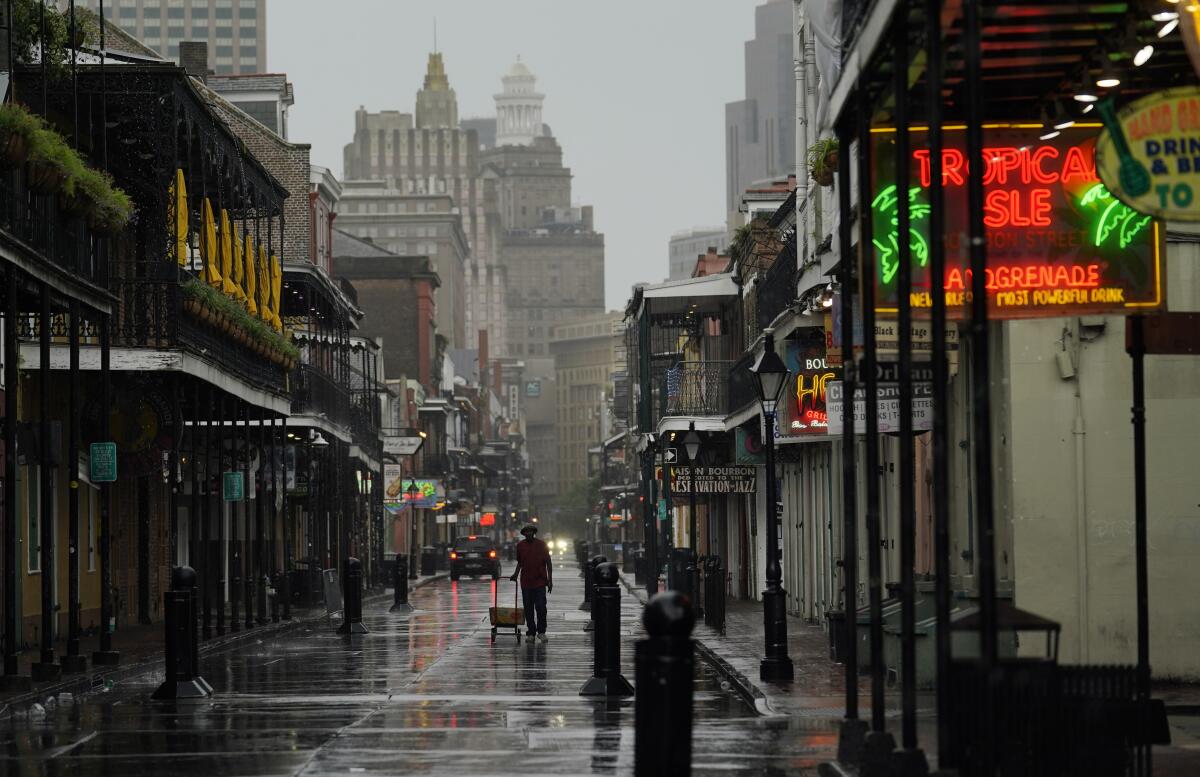A Hurricane Ida unknown: The economic impact

Hurricane Ida, which barreled through Louisiana with high winds and heavy rain Sunday, could damage the energy-heavy Gulf Coast economy and potentially have economic consequences well beyond the region.
The Gulf Coast is not only a major base for oil and natural gas companies but also a vital hub for the nationâs chemical and shipping industries.
Companies evacuated oil and gas platforms south of Louisiana ahead of the hurricane. But a far greater worry was potential damage to refineries and petrochemical plants in its path from flooding and storm surge.
A new program involving local subsidies aims to help middle-income Californians afford better housing. Critics say itâs a bad use of public funds.
Nearly 300 offshore platforms â or half the manned platforms in the Gulf of Mexico â were evacuated ahead of the storm, their production temporarily halted, the U.S. Bureau of Safety and Environmental Enforcement said on its website Saturday. Floating rigs also cleared out. In all, more than 80% of gulf oil and gas production halted, the agency said.
But a potentially more serious concern was the fate of refineries and petrochemical plants along the Mississippi River between Baton Rouge and New Orleans, near where Ida made landfall late Sunday with top winds of 150 mph.
Louisianaâs 17 oil refineries account for nearly one-fifth of the nationâs refining capacity and can process about 3.4 million barrels of crude a day, according to the Energy Information Administration. Many could be vulnerable to flooding. The agency said Ida could affect local energy supplies â especially transportation fuel and electricity.
Less clear is whether the domestic fuel supply might be affected. U.S. daily oil consumption is a little less than 20 million barrels a day. Analysts said it was too early to say, though S&P Global Platts said the storm could halt production of 765,000 barrels a day in gulf output.
It was not immediately clear how many refineries and petrochemical plants might be shut down.
Phillips 66 was halting production at its refinery on the Mississippi just south of New Orleans in Belle Chasse, La., due in part to âthe potential for storm surge,â said company spokesman Bernardo Fallas. Its daily capacity is 250,000 barrels.
Exxon Mobil said its Baton Rouge refinery, which produces about 520,000 barrels of crude daily, continued to operate, and Chevron said it had shut down operations at terminals on the Mississippi River and Gulf Coast and their related pipeline systems. Shell, Marathon and Valero also have refineries close to the stormâs projected path.
âThe industry has been through this maybe too many times over the last few decades,â Peter McNally, an energy analyst at Third Bridge, said of the hurricane. Several refineries in Lake Charles, west of Idaâs projected path, suffered wind damage in Hurricane Laura a year ago.
Meteorologist Jeff Masters, who flew hurricane missions for the government and founded Weather Underground, said Ida was forecast to move through âthe just absolute worst place for a hurricane.â
Although refineries and petrochemical plants are generally built to withstand high winds, they are not necessarily prepared for high water, an increasing problem as global warming spurs higher rainfall amounts in big storms.
McNally said the industry is most concerned about flooding, which is what caused so much havoc in 2017 with Hurricane Harvey in the Houston area, where petroleum products were spilled at flooded tanker and chemical plants.
âLouisiana is low, so you are prone to the flooding. These things are built to withstand winds, but itâs flooding you have a tougher time dealing with,â he said.
Sixty percent of the gasoline used on the East Coast is shipped from the Gulf Coast, much of it through the Colonial Pipeline, which is in the stormâs path.
In addition to oil production, Louisiana accounts for 9% of U.S. natural gas yields. Last year, the stateâs two liquefied natural gas export terminals shipped about 55% of total U.S. LNG exports, according to the Energy Information Administration.
Associated Press writer Seth Borenstein contributed to this report.
More to Read
Inside the business of entertainment
The Wide Shot brings you news, analysis and insights on everything from streaming wars to production â and what it all means for the future.
You may occasionally receive promotional content from the Los Angeles Times.











